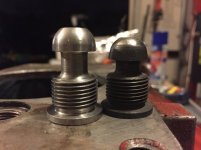Bolisk
Well-known member
When I bought this car, the previous owner said that the tans was rebuilt, and the clutch was replaced not long before the car was parked for 20 years. I pulled the trans because it was leaking. . .and found that it was rebuild by a monkey. Pulled the bell housing and the clutch looks new. Still very clean. It's a Borg and Beck.
Before pulling everything apart, the only problem I had with the clutch and trans was the fact that I had to push the clutch pedal through the floor to get the clutch to disengage. No matter how much I adjusted it. . .I could never get the clutch to disengage without pushing the pedal as far as I could get it to go.
When I got under the car, I found that I was pushing the fork into the firewall and it was leaving a mark in the fiberglass.
The first thing I can think of is that the fork ball stud is the wrong lenght. I pulled it out, and the stud is 1 & 3/8" long when you stand it up on a flat surface. The replacements from Paragon and Volunteer Vette appear to be 1& 1/2" long.
Does anyone know what the correct stud length is for a 72 LS5 car? Will the 1.5" really make that much of a difference?
Regards,
JonR
Before pulling everything apart, the only problem I had with the clutch and trans was the fact that I had to push the clutch pedal through the floor to get the clutch to disengage. No matter how much I adjusted it. . .I could never get the clutch to disengage without pushing the pedal as far as I could get it to go.
When I got under the car, I found that I was pushing the fork into the firewall and it was leaving a mark in the fiberglass.
The first thing I can think of is that the fork ball stud is the wrong lenght. I pulled it out, and the stud is 1 & 3/8" long when you stand it up on a flat surface. The replacements from Paragon and Volunteer Vette appear to be 1& 1/2" long.
Does anyone know what the correct stud length is for a 72 LS5 car? Will the 1.5" really make that much of a difference?
Regards,
JonR






